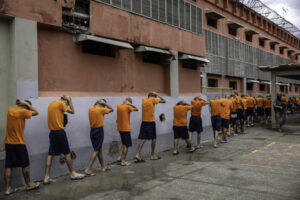By Adam Isacson
Once Congress gives the green light, the national security team for Barack Obama’s second term will have three new names at the top: John Kerry at State, Chuck Hagel at Defense, and John Brennan at CIA.
Kerry and Hagel are both Vietnam veterans turned Senators, both supportive of a strong, modern military but skeptical of large, open-ended military missions, sort of in the Colin Powell mode. Brennan is a career spy whose focus since the 1990s has been counterterrorism.
Only Kerry has much of a record on Latin America. In the 1980s, he was a leading opponent of the Reagan administration’s aid to abusive militaries, and to the Nicaraguan contra rebels, in Central America. He has also been a frequent critic of U.S. policy toward Cuba. In 2000, Senator Kerry shifted gears and supported a military aid package, President Clinton’s initial appropriation for Plan Colombia, though he later signed at least one letter criticizing Colombia’s human rights performance.
As David Sanger notes in today’s New York Times, all three nominees share a preference for a “light footprint” in the U.S. military’s activities abroad. Brennan, Sanger notes,
devised the “light footprint” strategy of limiting American interventions, whenever possible, to drones, cyberattacks and Special Operations forces. All are advocates of those low-cost, low-American-casualty tools, and all have sounded dismissive of attempts to send thousands of troops to rewire foreign nations as wasteful and ill-conceived.
With the notable exception of the 2009 Afghan “surge,” frequent but low-profile military and intelligence operations have been a hallmark of the Obama administration so far. With the ongoing drawdown from Afghanistan ahead of a planned 2014 pullout, the “light footprint” approach is going to accelerate.
How will this affect Latin America? Probably four ways, in declining order of importance:
- More Special Forces deployments to the region. President Obama and his new appointees share a fondness for Special Operations Forces: elite, highly trained, mobile military units used for non-traditional, often clandestine missions ranging from hostage rescues to hunting down wanted individuals to intelligence-gathering and “defense diplomacy.” Special Forces are likely to see their numbers increase despite upcoming defense budget cuts, and as the Afghanistan drawdown proceeds, there will be even more of them available to carry out missions in Latin America. Last year, the New York Times noted, Adm. William McRaven of the Special Operations Command was “pushing hard” to “expand their presence in regions where they have not operated in large numbers for the past decade, especially in Asia, Africa and Latin America.”
This doesn’t necessarily mean that Delta Force, SEAL Team 6, and other JSOC units will be carrying out clandestine mayhem in places like Venezuela and Cuba. (And if it does, we’re unlikely to find out about it.) But a recent conversation with a Defense Department official confirms that, in the next few years, we are likely to witness an increase in Special Forces training missions in the region. More teams will be in countries throughout the Americas teaching courses as part of Mobile Training Teams (MTTs), and organizing exercises, some of them through the Joint Combined Exchange Training (JCET) program.
Such deployments fulfill more than just training missions, though. They allow Special Forces units to familiarize themselves with the terrain, culture, and key officers in countries where they might someday have to operate. And they allow U.S. personnel to gather intelligence on their host countries, whether through active snooping or passive observation.
- A greater intelligence community presence is another likely consequence of a “light footprint” in Latin America. We can only speculate, but it is reasonable to expect fewer CIA assets in Afghanistan to mean more personnel focused elsewhere, including Latin America. Even more significant may be an increase in the presence of the Defense Intelligence Agency (DIA), the Defense Department’s spy agency. As the Washington Post reported in December, the DIA expects to roughly double the number of clandestine operatives it deploys worldwide over the next few years.
- Greater use of drones and robotics. The Obama administration has expanded the CIA and Defense Department use of armed unmanned aircraft to hunt down suspected terrorist targets. Brennan, the new CIA director, is known for being intimately involved this practice, which is extremely controversial because of reports that the drone program may have killed hundreds of innocent people in Afghanistan, Pakistan and elsewhere.
In Latin America, a few U.S. defense officials have confirmed to us recently, the U.S. military is not using weaponized drones, though it is employing some surveillance drones to detect suspect trafficking activity, particularly (but not only) above international waters. All officials have insisted that U.S. drones are not used extensively in the region, as they are costly to operate. However, as assets are drawn down from Afghanistan and as costs continue to drop rapidly, it is reasonable to expect the Obama administration to use them more frequently in the Americas.
The U.S. effort, however, may pale in comparison to Latin American countries’ own drone programs. Several countries—Colombia, Venezuela, and especially Brazil—are developing their own programs, and several more are buying drones, especially from Israel. While none of these drones are reportedly weaponized and there have been no reports of unauthorized cross-border drone flights, the increased affordability of drones, and the lack of norms governing their use, promises to pose a big challenge for Latin America within the next 5-10 years.
- More emphasis on cyber-security. As today’s New York Times piece noted, cyber-warfare is an interest of all three of the Obama administration’s nominees. While it is unclear how this will play out in U.S. national security policy toward the Americas, it is reasonable to expect more resources devoted to cracking open, and even sabotaging, the computer networks of countries or organizations that the U.S. government views as a threat. (For more on cyber-security in the hemisphere, see the work of James Bosworth at Bloggings by Boz.)
Adam Isacson is WOLA’s Senior Associate for Regional Security Policy.

